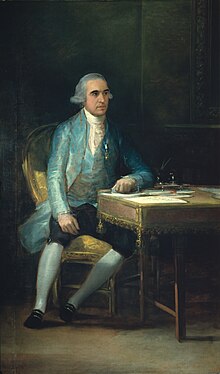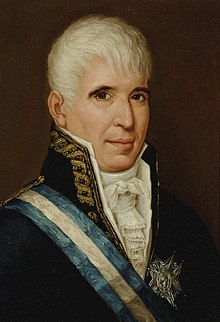Francisco Saavedra de Sangronis

Francisco Saavedra de Sangronis (* 1746 in Seville , Spain ; † November 25, 1819 ibid) was a Spanish officer and politician who briefly served as Prime Minister of his country under King Charles IV .
Life
Youth, training and careers in Europe
Francisco Saavedra was born into a high-ranking family from Seville. He studied law in Granada until 1765 . He then began his service in the Royal Spanish Army.
In 1776 he took part in the fatally failed punitive expedition of the Spaniards in Algiers . There he met Bernardo de Gálvez y Madrid . This introduced him to his uncle José de Gálvez y Gallardo when he had just taken over the colonial ministry. Saavedra moved there.
In the ministry he was entrusted with financial planning, but also worked on military strategies. In 1778 a plan was developed to conquer British Jamaica .
Commissioned in the War of Independence, imprisonment in Jamaica
When Spain entered the American War of Independence as an opponent of Great Britain in 1779 , Bernardo de Gálvez y Madrid succeeded in conquering Mobile (Alabama) . The Spaniards' next destination was Pensacola (Florida) , but Madrid was of the opinion that the army command in Havana would not react quickly enough to new turns in the war. As a strong man who was able to initiate troop movements and to secure the rapid financing of the campaign against the colonial bureaucracy, Saavedra was sent to Cuba with the first available ship.
A British warship (named Pallas ) boarded the Spanish frigate and Saavedra, like the other passengers and crew, was interned in Jamaica. Saavedra pretended to be a wealthy merchant. Since he was allowed to move freely on the island, he was able to study the fortifications and defense system of the British in detail. In January 1781 he managed to escape to Cuba on board a French ship.
Taking pensacola
In Cuba he met Bernardo de Gálvez, who described his situation and the means required to continue the campaign. On February 1, 1781, Saavedra called those responsible from the administration and the military together in Havana. In the following weeks he organized troops, weapons and ammunition with great difficulty and against considerable resistance in order to initiate the attack on Pensacola. The army sailed from Cuba on April 9, 1781. Saavedra followed the fighters and negotiated the surrender conditions with the British on May 9, 1781.
On May 16, he was back in Havana to write his report to the court. Here the news awaited him that his previous reports had had an effect: the governor and the commanders of the infantry and navy had been relieved, Gálvez had been promoted to commander in chief and promoted to lieutenant general. Saavedra himself was ordered to meet the French general François Joseph Paul de Grasse at Cape François on Hispaniola .
Saavedra-Grasse agreement
Grasse had come to Hispaniola with a strong French fleet. Together, the two agreed on a battle plan against the British. They sent this Grasse-Saavedra agreement to their governments, which they confirmed. The French wanted to land first in the Chesapeake Bay and there prevent the supply of the British, who held Yorktown (Virginia) under General Cornwallis . The second milestone was the liberation of the Leeward Islands (Antilles) from the hands of the British, before the final step was to conquer Jamaica, the largest and richest British possession.
The French, however, lacked the financial means to carry out the expedition to Virginia . Saavedra raised 100,000 pesos from the state treasury of Santo Domingo , but it was not enough. Until more funds arrived from Mexico , he quickly collected 500,000 pesos from the local population in Havana in early August 1781.
De Grasse sailed north and defeated the British at the Battle of Chesapeake , which was a major contributor to the British defeat at Yorktown. While de Grasse drove from there to St. Kitts , Saavedra gathered Spanish troops in Hispaniola to prepare for the conquest of Jamaica.
After initial success, the French under de Grasse suffered a decisive defeat at the Battle of Les Saintes : They lost four large ships and the Admiral de Grasse was captured by the British. Spaniards and French gathered their strength. While Gálvez and 10,000 men were waiting in Hispaniola for transport ships, the French withdrew the expeditionary forces under General Rochambeau from North America and waited in Venezuela for the invasion order. Saavedra went to Europe to organize further reinforcements, he acquired 12,000 French troops and 24 Spanish ships of the line.
However, the planned attack never took place. The peace negotiations and the subsequent Peace of Paris (1783) preempted the invasion plans. Nevertheless, the successes of the Spanish and French helped to tie up considerable British forces in the Caribbean that the British lacked in the fight against the American Continental Army .
Tenure in Venezuela
In June 1783 Saavedra was appointed Intendente or Governor of the province of Venezuela in Caracas in the viceroyalty of New Granada. He held this office until 1788. He returned to Spain after his tenure ended.
Term of office in Spain
First he was appointed to the highest council of war. In 1797 King Charles IV appointed him Minister of Finance under the government of Manuel de Godoy . After his fall, he took over the office of Prime Minister ( Primero Secretario de Estado ) in March 1798 , which he held until August 1798. He was followed by Mariano de Urquijo y Muga in office.
Saavedra withdrew to her native Andalusia. In the wake of the Napoleonic invasion of Spain, he returned from retirement in 1810 and took over commands during the Wars of Liberation. He then lived in seclusion in Seville, where he died on November 25, 1819.
literature
- Granville Hough: Spanish Heroes of the American Revolution: Francisco Saavedra de Sangronis . In: Somos Primos . ( somosprimos.com [accessed October 1, 2015]).
Web links
| personal data | |
|---|---|
| SURNAME | Saavedra de Sangronis, Francisco |
| ALTERNATIVE NAMES | Saavedra y Sangronis, Francisco de |
| BRIEF DESCRIPTION | Spanish officer, politician and Prime Minister |
| DATE OF BIRTH | 1746 |
| PLACE OF BIRTH | Seville , Spain |
| DATE OF DEATH | November 25, 1819 |
| Place of death | Seville , Spain |
